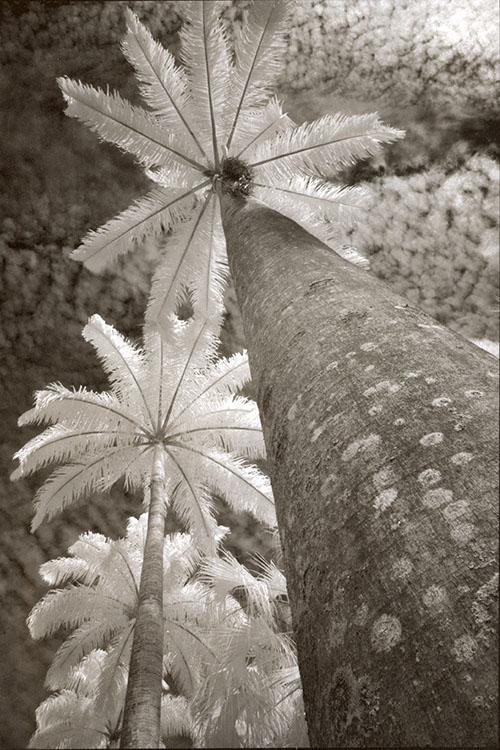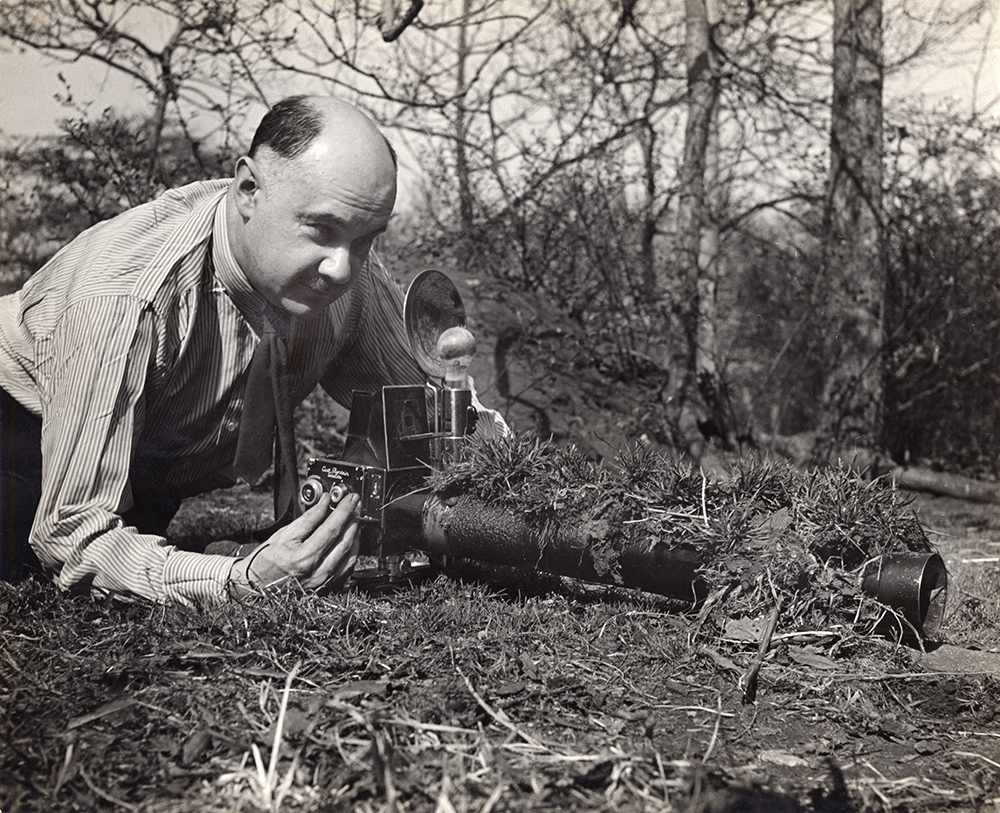The Endowment Fund for Education (EFFE) promotes and assists study and research in the field of biological communication by providing financial support to projects approved by the EFFE governing committee. Through EFFE grants, the Association promotes opportunities for the study and research of visual communication media in the life sciences.
 EFFE Grants for 2022
EFFE Grants for 2022
Danielle Edwards received an EFFE grant to produce hand coated platinum palladium prints of images taken in infrared. These images were in the exhibition “Visualising the Invisible” at the Thomason Library at Presbyterian College, Clinton, South Carolina, USA. The exhibition demonstrated how natural subjects can be interpreted differently when photographed in infrared and highlights the intersection between art and science. Dr. James T. Wetzel, Pulaski L. Bealy Smith Professor of Biology held a discussion on the interpretation of the natural world shown in the works with biology students.
This was followed up at BIOCOMM 2023 with a collaborative creative workshop held by Danielle Edwards and Dr. James Wetzel highlighting environmental themes in which an online gallery was made of the participants’ images.
 EFFE Grants for 2021
EFFE Grants for 2021
Robert Turner, RBP, FBPA, has been awarded a grant to have lectures transferred from cassette to digital and transcribed. The twelve audio tapes, "Breakthrough: Championship Living in a Computer Age," were created by Richard M. Byrne, PhD, Dean, Annenberg School of Communications, University of Southern California. Although they are three decades old, their message is especially relevant to people's careers in biocommunications and their lives! The transcribed content will be found in the JBC in a series of articles and the digital audio will be found on our new website.
Gale Spring, FBPA, has been awarded monies to purchase video equipment. The equipment will help create online educational video content to support teaching at RMIT. Online video content has become even more important with the pandemic and is replacing the traditional hands-on experience in labs, workshops and tutorials. He will begin to produce more content for specialized applications for education and contribute to the BCA's YouTube Channel and with an article about how he has experienced teaching during a pandemic.
 Matt
Croxton, MS, is our third applicant. Matt is a teacher at LCS RISE Institute in Florida and wants some much needed equipment for his students to capture fast moving specimens. Beginning
in the fall semester of 2021, LCS RISE students and faculty will be able to create better images for their science and engineering research by being instructed in the use of a modular action
camera system, adapted to a variety of relevant optical instruments. Not only is the requested modular imager applicable to science production tasks, but it will be a workhorse to make
communication products that enhance the impact and understanding of student projects. An educational and promotional video will feature footage or stills captured by students and faculty
using the imager. This video would also provide opportunities to spotlight the impact of the EFFE grant program to funders and prospective applicants.
Matt
Croxton, MS, is our third applicant. Matt is a teacher at LCS RISE Institute in Florida and wants some much needed equipment for his students to capture fast moving specimens. Beginning
in the fall semester of 2021, LCS RISE students and faculty will be able to create better images for their science and engineering research by being instructed in the use of a modular action
camera system, adapted to a variety of relevant optical instruments. Not only is the requested modular imager applicable to science production tasks, but it will be a workhorse to make
communication products that enhance the impact and understanding of student projects. An educational and promotional video will feature footage or stills captured by students and faculty
using the imager. This video would also provide opportunities to spotlight the impact of the EFFE grant program to funders and prospective applicants.
 In 2020, the EFFE Committee awarded Connie Johansen, FBCA an EFFE Grant for a project to
photographically catalog biofluorescent marine animals at the Port Townsend Marine Science Center in Washington. As the Citizen Science Coordinator Betsy Carlson explains, "Connie has been
assisting us by working with our aquarist to capture images of biofluorescence in our marine animals … as part of the process of developing an evening educational program." She also
adds that Connie will help them to better understand the equipment they have and how to take photographs of the microscopic organisms they look for in seawater. The Science Center hopes to
start a digital archive of phytoplankton collected from area sites.
In 2020, the EFFE Committee awarded Connie Johansen, FBCA an EFFE Grant for a project to
photographically catalog biofluorescent marine animals at the Port Townsend Marine Science Center in Washington. As the Citizen Science Coordinator Betsy Carlson explains, "Connie has been
assisting us by working with our aquarist to capture images of biofluorescence in our marine animals … as part of the process of developing an evening educational program." She also
adds that Connie will help them to better understand the equipment they have and how to take photographs of the microscopic organisms they look for in seawater. The Science Center hopes to
start a digital archive of phytoplankton collected from area sites.
Connie requested funds for the equipment she needs to proceed with this project including lenses, lighting, filters, and software. Connie will have extra time to prepare her presentation to share at the postponed BIOCOMM meeting in Santa Fe slated for 2022. She has also offered to lead a workshop on capturing biofluorescence in tide pool animals should we hold a future BIOCOMM Conference near a seaside location. Sign us up!
 To assist with financial support of BCA members participating in BIOCOMM meetings, the EFFE committee awarded John Yeats of Sydney, Australia the BCA BIOCOMM Educational
Support Grant in 2020. He will be able to use these funds for the upcoming BIOCOMM meeting in Santa Fe in October of 2022. John plans to present a session on the uses of infrared photography
in the clinical setting, particularly in regards to documenting conditions such as venous malformation. He hopes that his session will give medical photographers the confidence to offer this
type of service to medical practitioners. John is also planning to lead a section of the Videography Workshop when it is offered next year. His goal is to equip attendees with basic video
editing skills that will allow them to upload videos to such platforms as YouTube.
To assist with financial support of BCA members participating in BIOCOMM meetings, the EFFE committee awarded John Yeats of Sydney, Australia the BCA BIOCOMM Educational
Support Grant in 2020. He will be able to use these funds for the upcoming BIOCOMM meeting in Santa Fe in October of 2022. John plans to present a session on the uses of infrared photography
in the clinical setting, particularly in regards to documenting conditions such as venous malformation. He hopes that his session will give medical photographers the confidence to offer this
type of service to medical practitioners. John is also planning to lead a section of the Videography Workshop when it is offered next year. His goal is to equip attendees with basic video
editing skills that will allow them to upload videos to such platforms as YouTube.
Both Connie and John plan to write articles on their respective work for submission to the Journal of Biocommunication or other publications. We congratulate both as the recipients of EFFE Grants for 2020. Click here for further information on the Endowment Fund for Education (EFFE) Grant application and guidelines.
In 2019 two BIOCOMM grants were awarded to BCA members Charles Hedgcock, RBP, FBPA and Gale Spring, FBPA to present at BIOCOMM 2019. Gale produced a photomacrography publication for the BIOCOMM 2019 Photomacrography Workshop. Charles has written an article on the interesting collaborative collective of 6 artists and 6 scientists.
Gale Spring FBPA also received an EFFE grant to continue work on updating the photomacrography publication to include newer digital techniques such as focus stacking. This will be available to workshop participants and BCA members in 2020.
 EFFE Grant for Publication
EFFE Grant for Publication
Norm Barker and Howard Radzyner were awarded a $1500 EFFE grant for material for publication of an article in JBC on Roman Vishniac: The Curious Microscopist.
 BIOCOMM grant recipient John Yeats presented at BIOCOMM in Portland on Professional Clinical Photography to Assist Patients with Pectus Carinatum. John had been a BCA member
for three years and it was his first time to attend a BIOCOMM meeting.
BIOCOMM grant recipient John Yeats presented at BIOCOMM in Portland on Professional Clinical Photography to Assist Patients with Pectus Carinatum. John had been a BCA member
for three years and it was his first time to attend a BIOCOMM meeting.
One of John’s aims in this presentation was to make medical photographers feel good about their careers. There are many ways to achieve satisfaction in a job but one is to believe that your work is making a positive difference in another’s life. In the field of medical photography there is emphasis in the recording of pre and post treatment images for the purpose of documentation. However, in some situations photography can be an integral part of a patient’s medical management. The photography of patients with Pectus Carinatum, is one such example.
 Paul Crompton
FBCA, was awarded a BIOCOMM grant to present In Their Features and Countenance – The Study of Medicine, at BIOCOMM in Savannah.
Paul Crompton
FBCA, was awarded a BIOCOMM grant to present In Their Features and Countenance – The Study of Medicine, at BIOCOMM in Savannah.
Paul is in the process of writing a book on the history of medical photography. He found the task was quite extensive and made the decision to write the history of medical photography up to the 1900s. As early as 1802 physicians used photography as a means to document and study medicine.
Yeats and Crompton each received $2000 BIOCOMM grants.
Gale Spring, FBPA, was awarded a $1500 EFFE grant to continue his extensive work with camera conversions, lenses and filters for infrared photography. At BIOCOMM in Portland, Gale Spring, FBPA, RMIT University and Kathryn Denny, Queensland Police, discussed their experience and research into applications of infrared and ultraviolet imaging in forensic applications in their presentation, Infrared Photography – Considering the Best Approach for Desired Results.
 Digital imaging has greatly increased the interest in infrared (IR) photography. Since all digital sensors are sensitive to IR, this places the technique in the
hands of amateurs and professionals alike. They are no longer tied to special films and processes. Infrared imaging is a good artistic and creative tool as well as a scientific technique.
Digital imaging has greatly increased the interest in infrared (IR) photography. Since all digital sensors are sensitive to IR, this places the technique in the
hands of amateurs and professionals alike. They are no longer tied to special films and processes. Infrared imaging is a good artistic and creative tool as well as a scientific technique.
Many countries use infrared inks as anti-counterfeiting measures. The Hong Kong dollar is one of more striking examples of the use of inks transparent to infrared illumination. Left is visible light, the right is under infrared.